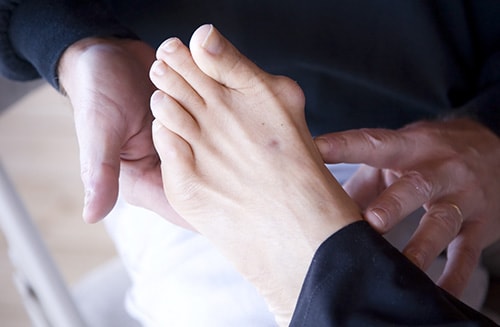Bunions
What Is a Bunion?
Bunions are very common foot deformities that affect the side of the foot and the largest toe. A large, bony bump begins to form along the foot at the joint at the base of the great toe—where it meets the long midfoot bone known as the first metatarsal. At the same time, your large toe begins drifting in the opposite direction, pressing into (or even crossing over or under) the second toe.
Do You Need Surgery for Bunion Treatment?
Not everyone with a bunion necessarily requires a surgical procedure. The main goal of bunion treatment is to eliminate pain and allow you to function normally. In some cases, this can be accomplished with conservative treatments designed to reduce pressure on the bunion and improve alignment. Topical and oral medications, changes in your footwear, and orthotics are all potentially effective options.
That said, conservative treatments will not cure your bunion. If you find that you are still experiencing pain, discomfort, or mobility limitations, it is probably best to get your bunion fixed via surgery.

Bunion Surgery
There are many different types of bunion surgeries. The specific procedure or procedures used will be selected based on the severity of the condition itself, as well as any other considerations about your general health, personal goals, or activity level.
Silver Bunionectomy
This procedure may be selected for simple bunions with relatively minor alignment issues. We make a small incision at the bump, then remove the prominence using a special saw or burr.
The surrounding capsule is cut and tightened in order to help maintain the correction. Because the surgery is less invasive, recovery is much quicker—most people are back in regular shoes within a month.
Scarf Bunionectomy
This is the most common procedure we perform. In it, the surgeon cuts through the first metatarsal bone in the shape of a sideways Z. This allows the bone to be realigned and repositioned in a more natural state. Any remaining “bump” will be removed and the repaired joint held in place with two to three screws.
The initial recovery period for this procedure usually lasts about 48 hours. After that, you will be in a walking boot for up to four weeks before you can return to wearing normal shoes.
Full recovery generally takes about 3 months. During that time, we may recommend physical therapy, laser therapy, splints, topical creams, or pain medications if they are necessary.
Lapidus Fusion
A fusion may be selected in the case of more severe bunions, or those caused by hypermobility at the joint between the first metatarsal and medial cuneiform bones (the TMT joint) in the middle of the foot. Here, the affected joint is fused to provide stability.
During the procedure, cartilage lining the TMT joint is removed. Bones are then straightened, and held together using appropriate hardware (such as screws, plates, and/or staples). Part of the bunion bump may also be removed, and the capsule surrounding the joint is cut to help maintain the corrected alignment.
Lapidus fusion requires a somewhat longer recovery, with up to 4 weeks of total non-weight bearing after the procedure using a knee roller or cam walker boot. Return to regular shoes may require 3 to 4 months, depending on swelling.
Additional Surgical Procedures
Sometimes, the surgeon may need to perform a secondary procedure alongside the main bunion surgery in order to provide the best outcome. The decision may need to be made at the time of surgery. These might include:
- Akin Osteotomy—a small wedge of bone is removed from the big toe in order to allow it to lie straight. This may be done with a minimally invasive approach, or using traditional staple fixation.
- Sesamoid Removal—the two tiny sesamoid bones act as “pulleys” underneath the big toe joint to help generate power. However, they often become dislocated as a result of a bunion. One of both may need to be removed.
- Second Toe Surgery—sometimes, the surgeon will also need to correct a dislocated second toe or perform other surgical procedures as needed. The need for a second toe surgery may not be apparent until the actual surgery is in progress. Any such decisions are made with your best interests in mind.
Our doctors offer extensive experience, specialized training, and board certifications in complex foot reconstruction and fixation techniques. We are proud to report a 95% success rate with our bunion surgeries. Among those who get bunion surgery, fewer than 1 in 20 suffer a recurrence.
If you are struggling with bunion pain, contact us for a consultation and discussion of your treatment options. You can schedule at our offices by dialing 702) 213-9093.
